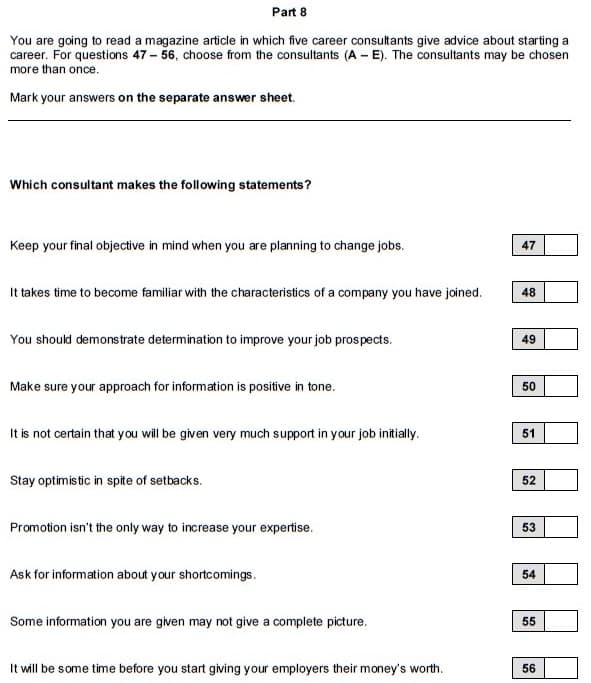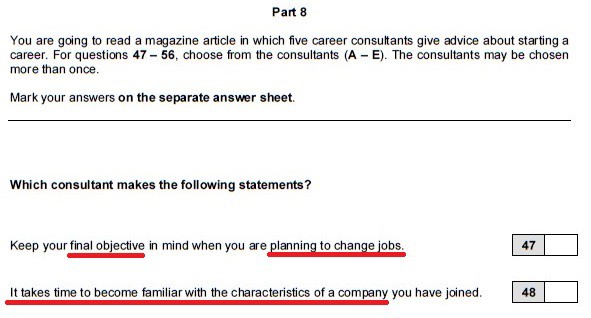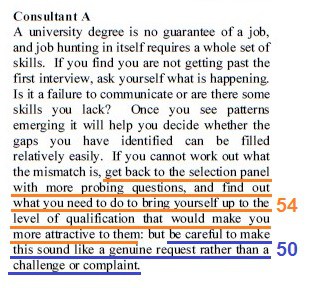Reading and Use of English Part 8
Reading and Use of English Part 8 is one of the tasks where you can see very quickly what a difference good strategy makes. When a new student comes to one of my classes, they often struggle because they are not really sure what to do, but as soon as I introduce them to my ancient teachings ;), they appear to be just fine.
However, there are certain problems that I commonly find but also typical solutions for these exact issues.
In this article, you are going to find all the information you need to become a boss when it comes to Part 8. I’m going to show you what the task looks like, what exactly you should do as well as some of the things you shouldn’t do if you want to be successful.
Before we get started, I would like to say that only focusing on single tasks is good in its own right, but it is definitely just as important to get more of a bird-eye view and look at the exam paper as a whole. Therefore, I’ve written an article about Reading and Use of English in general where I talk about global strategies that can help you become more efficient and confident. If you want to learn more, simply follow the link below.
>>> Everything you need to know about C1 Advanced Reading and Use of English <<<
What do you have to do in Part 8?
Part 8 – Multiple matching: You read one longer text or several short texts and you get ten questions. Each question/prompt must be matched to a part of the text. Each part might contain the answer to more than one question.

In Part 8, you always get the questions first. You can see above that there is some information about the task and a question followed by the ten prompts.

The text can be broken up into different parts. In our example, we’ve got five short texts. These five parts need to be matched to the prompts from the previous image.
Reading and Use of English Part 8 tests your understanding of ideas, opinions and attitudes. You need to show your ability to find paraphrased statements quickly without getting distracted by similar yet wrong passages in the other short texts.
Together with parts 1, 5, 6 and 7, Part 8 makes up the reading portion of the exam paper. If you haven’t looked at the whole paper yet, I definitely recommend doing so. As I mentioned earlier, I have written an article on the topic showing you what Reading and Use of English looks like, what you need to consider plus some useful tips regarding the sequencing of tasks and time management. If you are interested and want to find out more, just follow the link below.
>>> Learn more about C1 Advanced Reading and Use of English <<<
The 3 most common problems with Part 8
In order to improve and to learn from your mistakes you first need to know what the problem is. In Reading and Use of English Part 8, there are certain issues that I witness over and over again and the solutions are the same every time I see them.
Most of the time, I find one or a combination of the following three problems. So, let me share with you what they are and after that, we can look at how to avoid these traps and become great at Part 8.
Candidates don’t analyse the questions properly
C1 Advanced and especially Reading and Use of English is really all about paraphrasing. You always need to think about how you could say certain things in a different way and some of the tasks in the exam explicitly ask you to transform words like in Part 3 or even whole sentences (Part 4).
However, without careful analysis of the questions, you won’t be able to understand what to look for and this applies to Part 8 as well. It is hugely important to look at the prompts with care before diving into the matching part of the task, but many candidates neglect or completely skip this part, which can cost them valuable marks.
Candidates don’t have a plan
Just like the previous problem, candidates tend to forget about this very quickly and get themselves into trouble just as fast. If you want to be successful in C1 Advanced, you should have a strategy for every single part of the exam with Reading and Use of English Part 8 being no exception.
Unfortunately, it is not easy to come up with a plan when you are new to the exam, but that’s why you are reading this article anyway, isn’t it? In the next section on tips and strategies, you will learn step by step how to navigate through Part 8 so keep on reading.
Time management
The last one of the three main problems with Reading and Use of English Part 8 is directly connected to the first two but deserves an honourable mention.
Without knowing how the task works nor a strategy you will most certainly get yourself into time trouble. Not only is this true for Part 8, but it accumulates over the course of the exam paper so by the time you get to Part 8 you might already have wasted tons of time on the other tasks.
So, don’t be like the other candidates and work on a path that gets you through Reading and Use of English efficiently and effectively.
Tips and strategies for Part 8
When it comes to advice for Reading and Use of English Part 8, we can categorise the tips that I can give you in general and specific advice as some of my suggestions can help you with your general language development while others tell you exactly how to get through Part 8. I’m going to start with the more general things before we dive into specifics.
General tips
My first piece of advice for anyone who wants to get ready for Reading and Use of English is to establish an English-language routine. It is so beneficial to immerse yourself into your target language as much as possible because at some point your brain switches to autopilot and you won’t have to think about how to express something in English anymore.
Of course, not everyone can spend hours and hours on practice every day and all the gurus on social media that tell you how easy it is to become fluent in six months don’t usually take into account that their viewers have lives to lead and that they can’t study and practise for 10 hours a day.
What I’m talking about is a routine that starts with 5-10 minutes per day. Choose a topic you like, for example. sports, music, films, make-up or whatever it is that gets you interested and look for articles or podcasts online. Use your commute to and from work or school to listen to something in English or invest a few minutes before going to bed in reading an article or watch a show on your favourite streaming service.
You will see that over time small improvements will happen. You won’t have to search your memory for certain words anymore when you are trying to explain something in class and your reading speed increases. You might also find that you understand the people in your listening practice better and better.
However, practice is key and the sooner your start, the quicker you can reap what you sow so pick up a book, download a podcast or choose a show in English online right now and begin your journey.
Follow a plan
The most important thing to keep in mind when doing Reading and Use of English is to make a plan for each individual part. A step-by-step process can help you stay focused and save a lot of time while, at the same time, not get stressed because you know exactly what to do in any given moment.
For Part 8, a possible plan might look like the one below:
- Analyse the questions
- Go through the text paragraph by paragraph
- Match the paragraphs to the questions
Obviously, you need a little bit more information about the different steps so let’s go into more detail.
Analyse the questions
In many parts in Reading and Use of English, I tell you to read the text first, but in Part 8 I recommend a different route. When you are presented with the exam, you will notice that in Part 8 the questions come first and they are followed by the text. Cambridge gives you a little hint here so we should pick up the ball and run with it.
Make sure that you read the prompts very carefully and underline the key information in each one of them so you know what you have to look for in the text.

In the two example questions above I underlined the key information which tells you what exactly you will have to look for in the text. Repeat this for the other prompts and you are ready to get started with the text.
Go through the text paragraph by paragraph
One of the biggest mistakes in Reading and Use of English Part 8 is that candidates try to complete the task question by question, which means they look at the first prompt and go through the whole text until they find the part that corresponds with the question, then repeat the same process with all the other questions.
The problem with this approach is that it takes tons of time and you possibly read the text six, seven, or even eight times until you have answered every single question.
Luckily, there is a better and time-saving process that can make the difference in an exam notorious for its tight time limit.
When you approach the task, make sure that you go through it paragraph by paragraph instead of question by question. Start with part A of the text and read it carefully looking out for any piece of information which matches the prompts. In our example task, that might look like this:

In the text by Consultant A above, I underlined the information that gives us the answer to two of the prompts in the task – number 50 and 54.
Match the paragraphs to the questions
As soon as you are sure that you’ve found a match, write down the answer and forget about it. Don’t doubt yourself or change your answers as this is just a waste of time. In Part 8, you only get one mark for each correct answer so don’t spend too much time trying to figure out which text is better than another one.

After you are done with text A, rinse and repeat with the other parts. With each completed paragraph, the number of possible prompts gets smaller so you should be able to speed things up the deeper you get into the task.
Other tips
As mentioned in the section on the three most common problems, good time management is crucial to passing C1 Advanced and especially Reading and Use of English. You need to be aware of how long it typically takes you to complete the different tasks in order to get an idea of which parts you have to work on and which ones already work well.
There are different ways of looking at this issue, but apart from working on each part individually, you can also look at the sequence of tasks as a whole and determine what order works best for you.
Due to the multitude of options when it comes to sequencing, I added a section in my article on C1 Advanced Reading and Use of English so you can benefit from my years of experience and experimentation. Simply follow the link below and see for yourself.
>>> How to sequence the tasks in Reading and Use of English <<<
I leave it to you
Now that you have all the information about Reading and Use of English Part 8 that you could possibly need, I leave it to you to practise and work hard to get to where you want to be.
My advice has already helped hundreds of people to achieve their goal of passing Cambridge exams and I hope it will do the same for you.
Lots of love,
Teacher Phill 🙂














